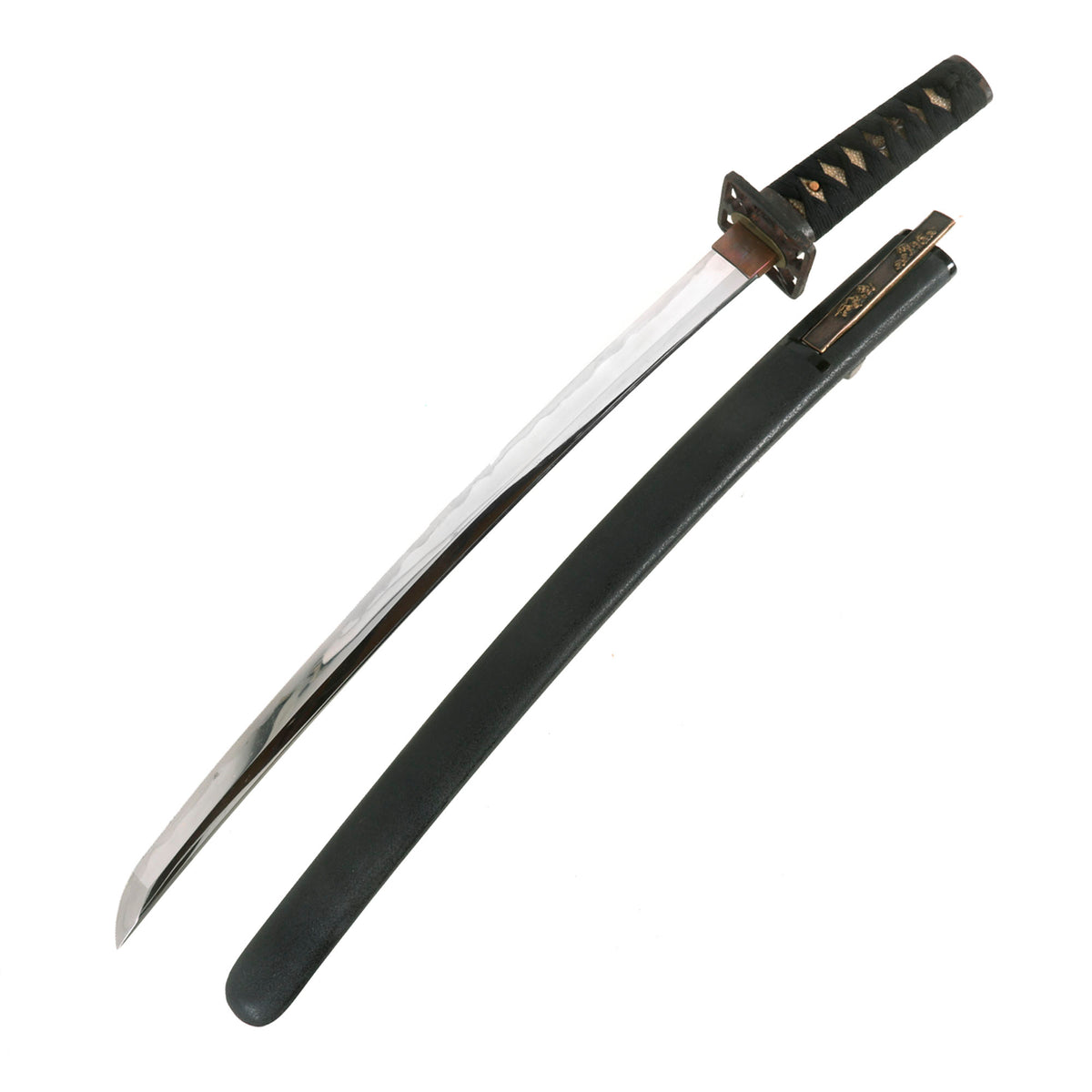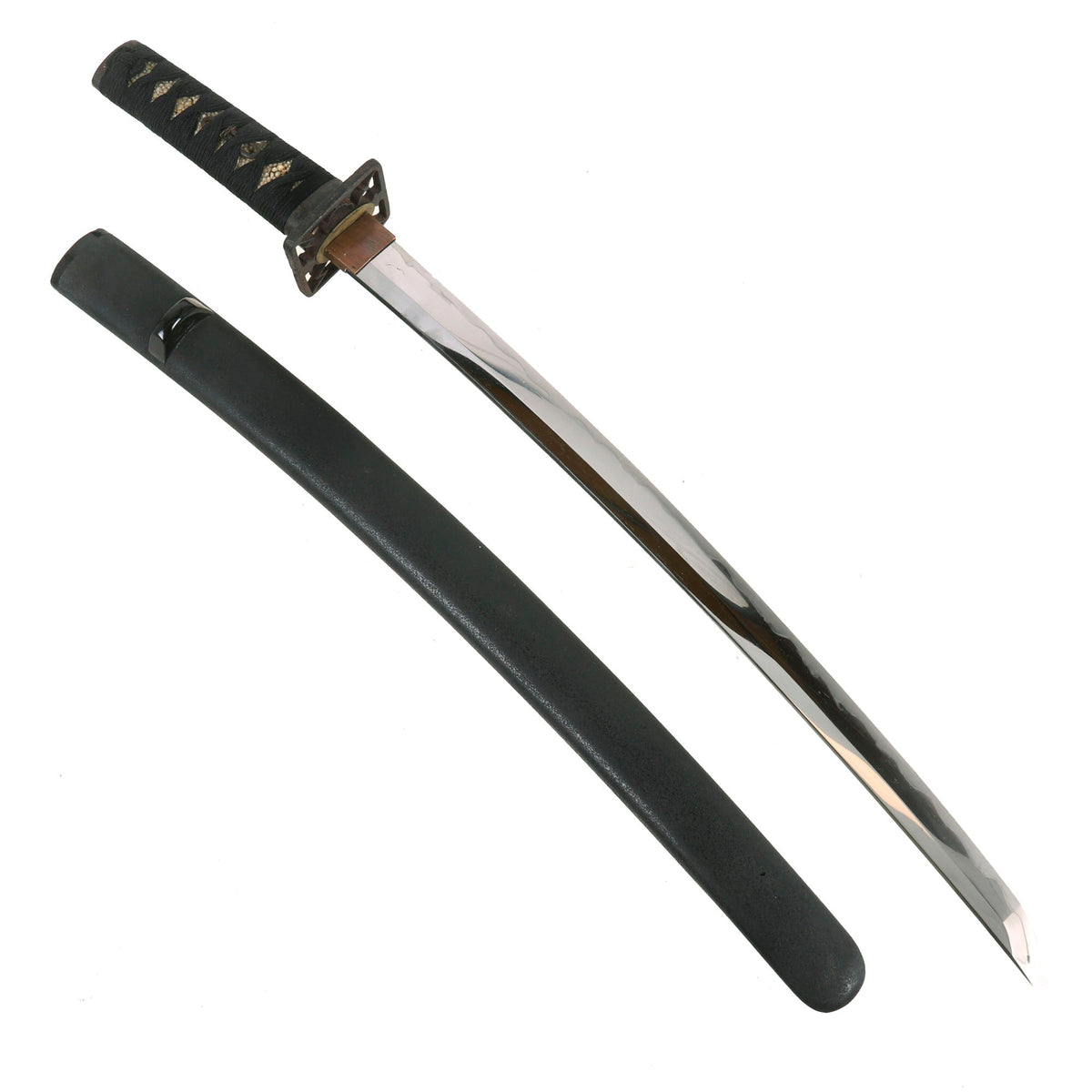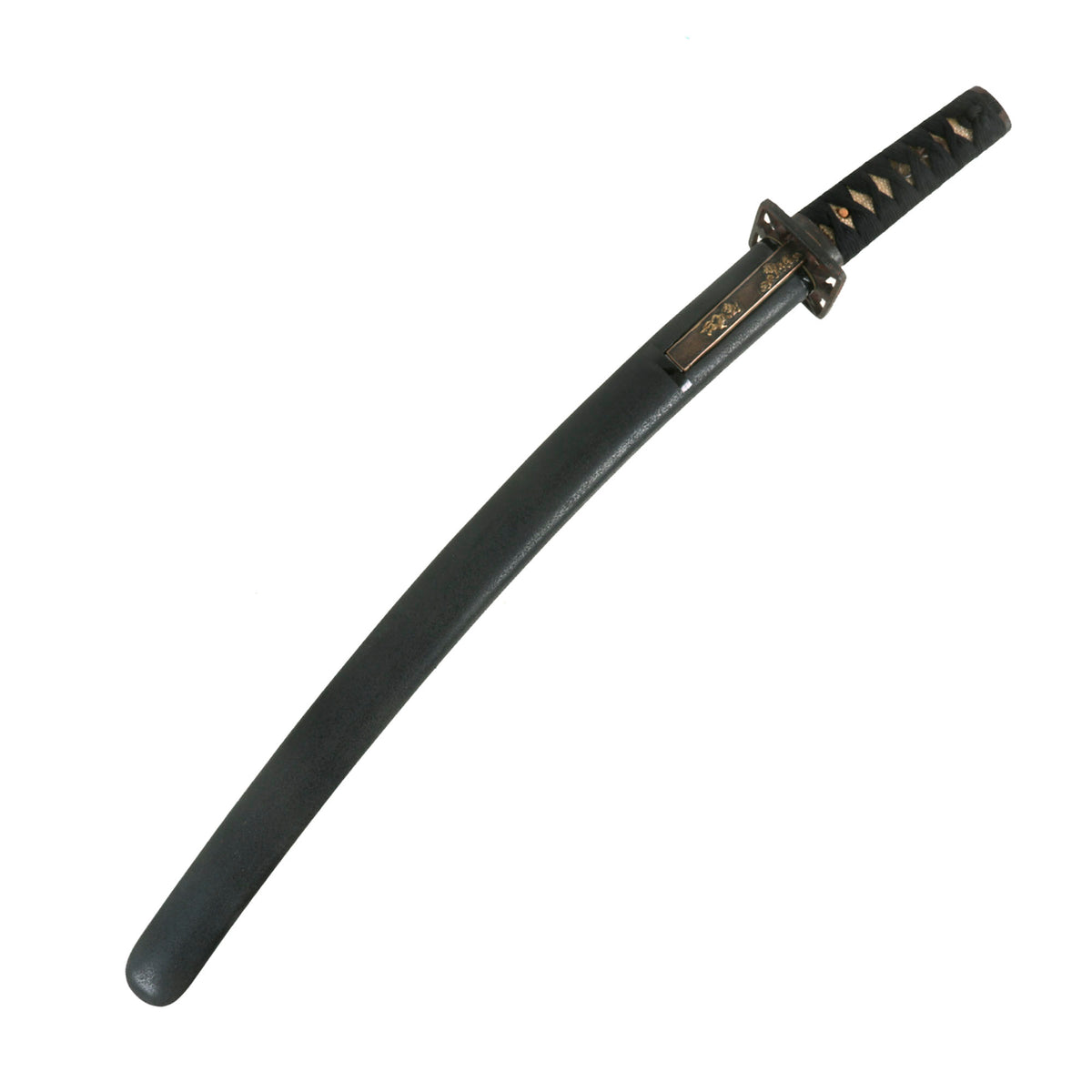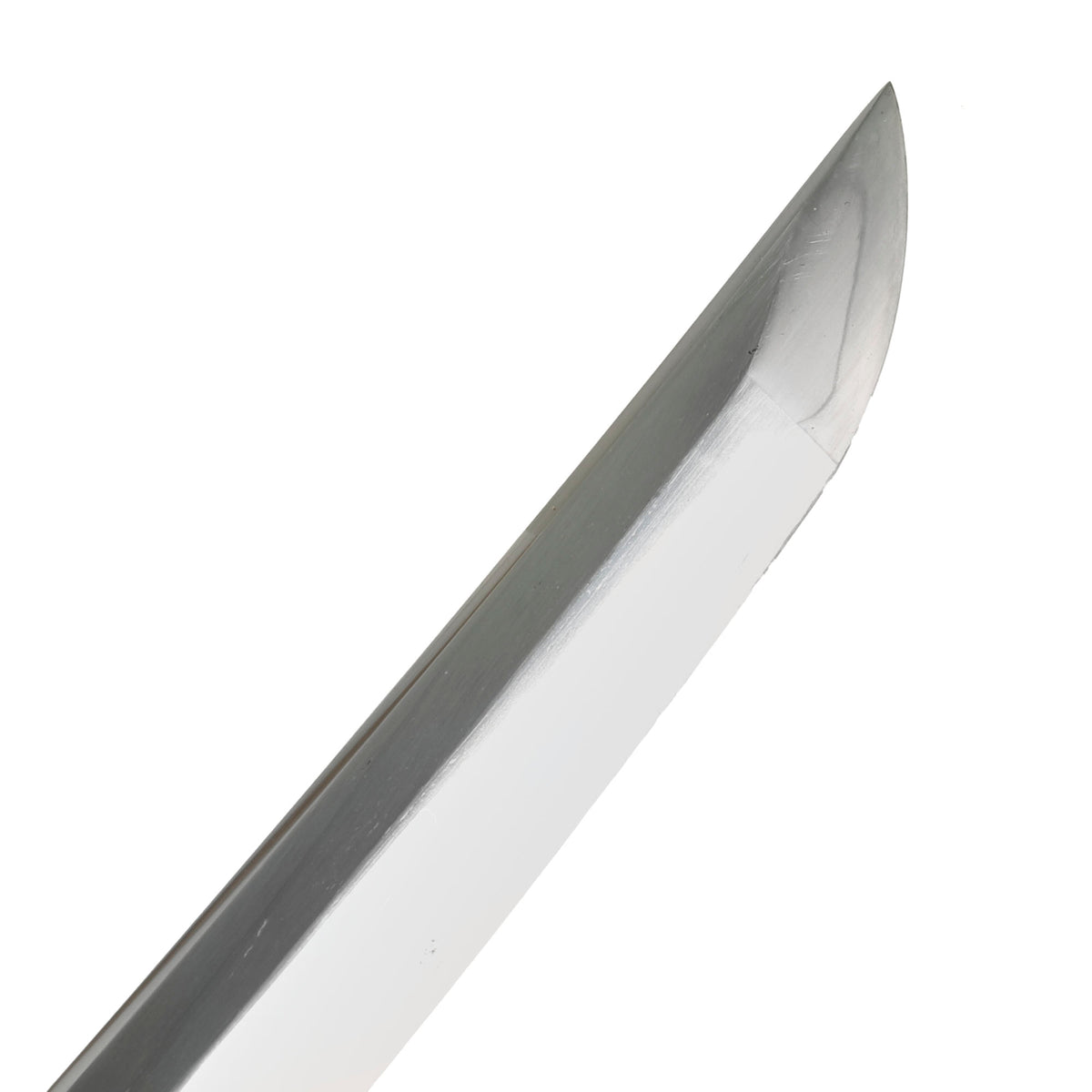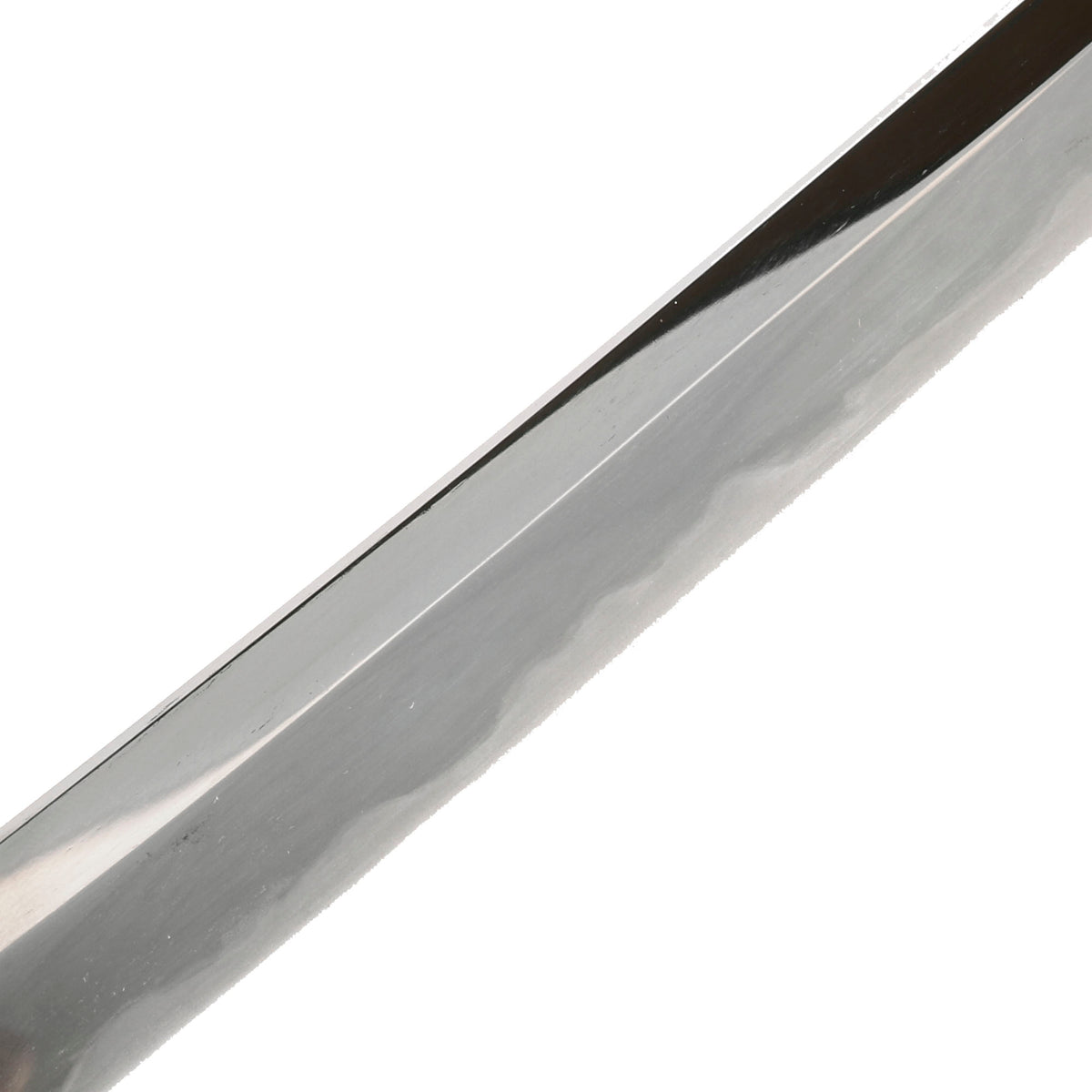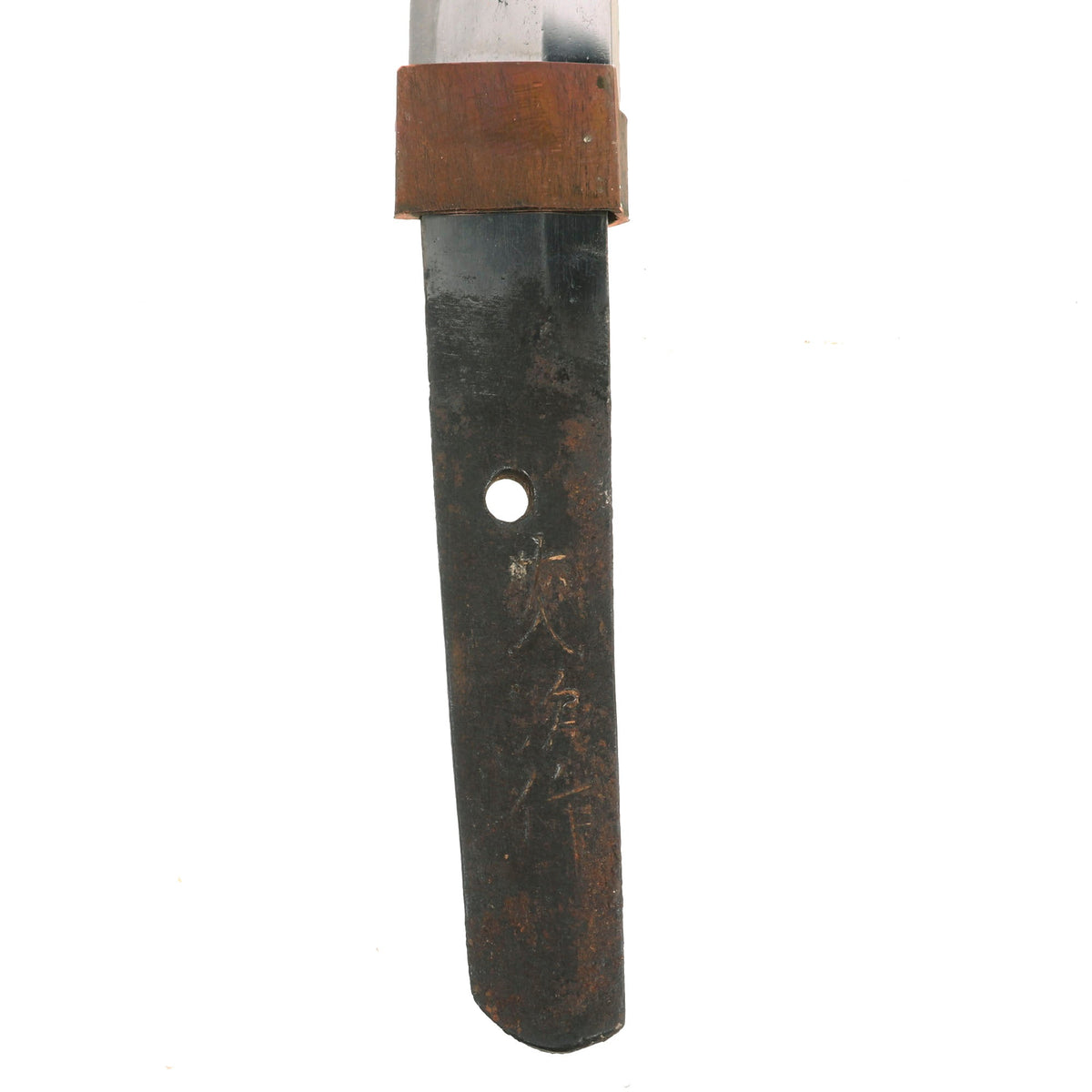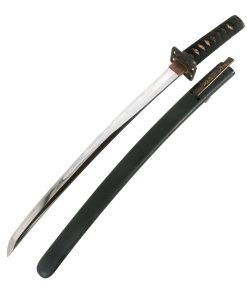Original 16th Century Muromachi Period Japanese Handmade Ō-Wakizashi Short Sword by TOMOTSUGU with Kogatana Knife and Scabbard Original Items
$ 2.795,00 $ 698,75
Original Item: Only One Available. Wakizashi (脇差 “side inserted / companion sword”) is a general term for a sword with an edge between one and two shaku long (30 cm and 60 cm), predominantly made after 1600. Generally it is the short blade that accompanies a katana in the traditional samurai daisho pairing of swords, but may be worn by classes other than the samurai as a single blade, also worn edge up as the katana. Here we have a wonderful example in excellent polish, which was probably refit later in the Edo period, and comes complete “en suite” with matched fittings and a kogatana knife.
As best we can tell, this example dates from the late Muromachi period (室町時代 Muromachi jidai) of 1336 to 1573, most likely the earlier portion. This is part of the period of Japanese swordmaking known as Kotō (古刀”old swords”), the the type of swords that later smiths treated as the goal they needed to achieve. As the blade length is close to that of a Katana, and the blade is the “Shinogi-Zukuri” shape, some would term this an “Ō-Wakizashi”. This example has probably been remounted several times, as was common for Japanese blades that are several hundred years old, with the last time probably occurring in the late 19th Century. It was then probably brought back to the US during the WWII era.
Age and wear have made the YASURIME (鑢目 – file marks) on the tang faint, and given it a lovely patina, with some areas of oxidation scaling. There still is some of the tagane-makura (raised area around the mei) present, and the tagane (chisel marks) faint, however the MEI signature is still relatively easy to read. As best we can tell it reads 友 次 作 – TOMOTSUGU SAKU, or “Tomotsugu made this”. This is a very well regarded name and lineage in Japanese sword making, with a history going back into the Muromachi period. We believe this is the one from Echizen province, who was active in the very late Muromachi period, circa 1570. They were a member of the Fujushima school of sword making. There were two others who used this specific three character signature, who made swords slightly earlier. It is a really lovely blade worthy of further research with OSHIGATA signature records.
The blade has the following period correct features:
– Folded steel blade (fold lines are evident on the spine and body of the blade)
– Hole (mekugi-ana) in the tang is punched and not drilled
– Blade is signed by the maker (Mei)
– Vibrant isible temper line (“hamon”) running full length of blade cutting edge.
– Blade has a proper geometric kissaki (tip) and boshi (tip temper line)
– Blade wounds (kizu) or lamination artifacts are present on the blade. Ware (lamination lines) are visible in several areas.
Offered in magnificent condition, the polish on the blade of this example is excellent, showing that very little use and cleaning has happened since the last polishing. There are just a few minor spots of oxidation, and the aspects of this blade are able to be easily appreciated in any kind of light. It is still quite sharp, with no edge issues we can see, and should be handled with care. The blade length is approximately 17 ¼” and overall length 23 ¾”. It has a futsu 普通 (regular) Nakago with an Haagari (asymmetrical rounded) nakago-jiri (tang tip). The blade shape is SHINOGI-ZUKURI, which is the “standard” shape for most Katana and longer wakizashi. Many would term this an “Ō-Wakizashi” as the length is relatively close to a Katana.
The blade has a proper kissaki (tip) with a clear yokote (division between body and tip) and boshi (tip temper line). The main edge Temper line (hamon) is fully visible, and is a very attractive NOTARE MIDARE (湾れ乱れ – irregular wave like) shape, with lots of internal activity. It has portions that resemble other Hamon patterns, making it a real joy to examine. Along the transition there are clear NIE crystals visible, with cloudy areas of NIOI in the body of the hamon, and some nice activity. The body of the blade (JI) also shows faint hada (肌 – grain), which is the AYASUGI (綾杉 – large wavy) shape. The tip temper line (boshi) is fully visible, and looks to be the Ko-Maru (小丸 – small circle turnback) shape, with a clear transition. There are also some KIZU blade wounds visible, mostly WARE lamination lines, only possible on true handmade blades. This is really a fantastic looking blade! With the long delay for traditional togishi polishing, blades like this that are ready to display are definitely in demand.
The patinated tsuba (cross guard) is made of iron and is of the KAKU GATA (square) shape, and is quite perforated, almost skeletal in construction. It has two Hitsu-ana accessory holes, one for the Kozuka (kogatana handle) and one for a kogai hair ornament. This allows the accessories to be taken out without unsheathing the sword, though only the kogatana is included in this listing. There are two metal seppa to help keep the tsuba from wobbling. The sword has a copper blade collar (habaki), typical of the Edo period.
The fuchi (collar) for the tsuka (handle) is made from patinated iron, and has some lovely inlaid designs, though they are quite faint. The kashira (end cap) is also of iron, and has some lovely decorations on the bottom. There are two menuki grip ornaments, which look to be some type of rope design. The stingray skin (Sa-Me) grip is in great shape, showing no splitting or other damage, and the black grip wrapping (Ito) is excellent, looking to have been redone during the 20th century. There is a single partial wooden securing peg (mekugi) still present, which could looks to be from the early 20th century.
The kogatana knife shows a nice patinated blade, which is still relatively sharp, and has a lovely gilt copper KOZUKA (handle), which shows some brass dog ornamentation on the front.
The sword comes well-fitting wooden scabbard (saya), which is finished with lovely textured black urushi lacquer with gloss accents. The scabbard has a slot for the kogatana knife, and also a KURIKATA knob, where a SAGEO sword cord might be attached. There is even some leather padding in the kogatana slot to keep it in place. Really a great looking scabbard!
A fantastic late Muromachi Period wakizashi by a known lineage of smiths with a blade in fantastic polish. with a nice set of Edo period fittings! Ready to research and display!
Specifications (Wakizashi):-
Blade Length: 20 ¾”
Blade Shape: Shinogi-Zukuri (鎬造)
Overall length: 23 ¾“
Scabbard Length: 19″
Specifications (Kogatana):-
Blade Length: 3 ⅞”
Overall length: 7 ⅝“
It has been over one thousand years ago that the art of making swords appeared in Japan. The swordsmiths of the time may not have known it but they were creating a legendary sword. The Samurai sword has seen combat in many battlefields. From the early days of the Samurai warrior to the fierce battles in the South Pacific during WWII.
Each hand-made Japanese blade (日本刀 – Nihonto) is unique because it is forged from multiple pieces of folded steel stock. A tremendous amount of work is dedicated to creating these pieces. They were an instrument of war as much as a beautiful artifact to adorn a room.
The traditional Japanese blade and mountings have grown to be one of the most highly desired military antiques.
Fast Shipping with Professional Packaging
Thanks to our longstanding association with UPS FedEx DHL, and other major international carriers, we are able to provide a range of shipping options. Our warehouse staff is expertly trained and will wrap your products according to our exact and precise specifications. Prior to shipping, your goods will be thoroughly examined and securely secured. We ship to thousands clients each day across multiple countries. This shows how we're dedicated to be the largest retailer on the internet. Warehouses and distribution centres can be located throughout Europe as well as the USA.
Note: Orders with more than one item will be assigned a processing date depending on the item.
Before shipping before shipping, we'll conduct a thorough inspection of the items you have ordered. Today, the majority of orders will be delivered within 48 hours. The delivery time will be between 3-7 days.
Returns
The stock is dynamic and we cannot completely manage it because multiple stakeholders are involved, including our factory and warehouse. So the actual stock may alter at any time. It's possible that you may not receive your order once the order has been made.
Our policy is valid for a period of 30 days. If you don't receive the product within 30 days, we are not able to issue a refund or an exchange.
You can only return an item if it is unused and in the same state as the day you received it. You must have the item in its original packaging.
Related products
Uncategorized
Uncategorized
Uncategorized
Uncategorized
Uncategorized
Uncategorized
Armoured Fighting Vehicles of the World: AFVs of World War One (Hardcover Book) New Made Items
Uncategorized
Uncategorized
Uncategorized
Uncategorized
Angolan Rebel 1970s era 60mm Inert Display Mortar from Angolan Civil War Original Items
Uncategorized
Australian WWII Owen MK1 Machine Carbine SMG Custom Fabricated Replica with Sling Original Items
Uncategorized
Uncategorized
Uncategorized
Uncategorized
Uncategorized
Uncategorized
Uncategorized
Uncategorized
Band of Brothers ORIGINAL GERMAN WWII Le. F.H. 18 10.5cm ARTILLERY PIECE Original Items
